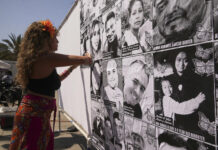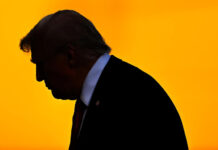DECEMBER 31, 2019

Move around a bit as you’re being photographed – even if it’s just walking or a flick of a dress – it shows a moment in time and it’s real. Photograph: Martin Sanmiguel/Getty Images
New Year’s Eve should be the perfect occasion for photographs – friends get together, everyone dresses up.
But often by the end of the night you’re left with a stack of blurry, grainy or generally mortifying pictures.
Tiah Eckhardt, a model and blogger who’s turned posing into a fine art, and Sonny Vandevelde, a fashion photographer known best for his joyous backstage shots, chime in on how even amateurs can walk away from the night with happy snaps they’re actually happy with.
Look into the light
“The first thing I always think about is light … where’s the light source coming from?” Eckhardt advises. “Is it an on-camera flash? Is it coming from the side? Above, below? I will reflexively change my position for the light … There’s certain things that look flattering in photos and that people universally find attractive.” She suggests posing to emphasise your cheekbones, and ensure light is hitting your eyes – even if it feels uncomfortable in the moment – so they’ll look brighter in the picture. “If you’ve got a light above you and you tilt your head up to the light, it’ll cast a shadow down your cheek bones and makes your mouth look like a nice shape, it’ll get the light into your eyeballs. Where as if you tilt your head down, under an overhead light, you’ll look like a skull. You literally look like a decaying corpse.” If the light is coming from below “tilt your head down because that’ll get the same result – light bright eyes.”
Use flash wisely
While it might work alright for a posed, group photograph, Vandevelde suggests: “When you take a photo on the iPhone with flash, it takes so long, and that moment’s gone.” He says in the seconds between taking the photo and the flash going off, your subject might be halfway across the room. “It’s not getting those in the moment shots. It’s not getting those candid shots.”
Eckhardt too notes that camera phone flashes can be “brutally unforgiving”. If you’re shooting in low light, and your smartphone’s flash is the only option, she suggests “you’re going to want to look directly at [the camera]. Don’t tilt up, don’t look down and maybe lift your neck towards the flash. Tilt your body back, lean forward on a slight angle, and that’s going to be the most flattering way of coping with the hell that is a cellphone camera flash.”
Consider going analogue
“It’s hard to look bad in a Polaroid,” notes Eckhardt. In terms of posing for Polaroids, she suggests using a similar technique to posing for other flash photographs. “A Polaroid camera is much the same thing because it’s an on-camera flash, but it’s more flattering.”
Vandevelde agrees: “I love Polaroids.” However, he warns “the problem is over time they will fade. So I always tell people if you’ve gone out at night and taken a whole bunch of Polaroids and have great shots, do yourself a massive favour and get them on a flatbed scanner and scan them at 300DPI so you’ve got a good digital copy as well. In 10 years time the UV will have faded the Polaroid, but you’ll have a backup.”
He also suggests that the wedding-party trick of handing out disposable cameras can work for other social occasions too. “But make sure you save a couple for later on in the evening!”
Don’t forget your settings
“It’s only worth working with a camera if you have experience with the camera and know how to change the settings,” says Vandevelde. This is true whether you’re using the inbuilt app on your smartphone, a smartphone app with more manual settings, or a DSLR.
For instance, when shooting at night, “if you use a flash and just have a camera on auto-settings, the background might become too dark. You’ll have a really nice exposure on the subject in the foreground but then you’re not capturing the ambience in the background.”
This is especially important for taking photographs with fireworks in the background. In those shots, if you’re not letting enough light into the photograph, the fireworks will “completely disappear”.
Plan before you pose
If you know you’re going to be posing for photographs, Eckhardt suggests taking a quick snap of yourself before you leave the house. She has won jobs with this trick before. “I would get ready for a casting and I would take Polaroids or a digital photo of myself after I’d done my hair and makeup, and if I didn’t look right, I would keep tweaking it until it looked good for the photo, not good to the eye … I knew once I left they’d look through 30 photos of me… So I didn’t do my makeup to look good for the person I was talking to, I did it to look good for the photos when they went back over them.”
Just before the camera goes off, she suggests thinking about something that will make your face light up. Posing is “like any kind of acting … with a camera you’ve got a second to do it. So you’ve got to think of something and then your eyes are alive.”
Vandevelde suggests moving around a bit as you’re being photographed, “If we’re talking about night-time and party and event photography, I prefer to capture movement, even if it’s just walking … a flick of a dress … When people are talking with each other and they’re smiling, capturing that reaction is a moment in time, and it’s real.”
More is more
Vandevelde suggests that you should not take your camera out at the beginning of a party. “I think the main key is wait till people have had a couple of drinks … people will get looser, they’ll start having more fun.” From there “the more photos you take the merrier. Snap away!”
Eckhardt loves candid shots, but she notes that often “it’s just luck. A candid photo is either brilliant or awful. And it’s brilliant because it’s capturing something genuine, or it’s awful because you’re doing something stupid. I think with a candid photo, four out of five will be awful and the other one will be great. Because you can’t fake whatever it is that you’re doing.”
Courtesy/Source:The Guardian






































































































